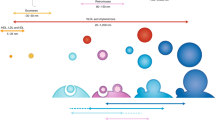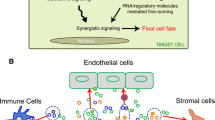Abstract
Cell-to-cell communication can occur in several ways, with or without cell contact. Exosomes play a role in one of the most recently discovered and versatile cell-to-cell communications, which do not require cell contact and that can act over long distances. The RNA content, mRNA and microRNA, is protected by the exosomes rigid membranes, which makes it possible for cells to communicate long-distance RNA messages via the circulation system. Their mRNA content differs substantially from their mother cell mRNA content, whereas their microRNA content seems to reflect their cellular origin more. This chapter reviews the role of exosomes in cell-to-cell communication and in particular the role of exosomal shuttle RNA (esRNA). This is a new and rapidly expanding field of research that has given cell-to-cell communication an increased complexity and that has great potential within both diagnostic and therapeutic applications.
Access this chapter
Tax calculation will be finalised at checkout
Purchases are for personal use only
Similar content being viewed by others
References
Harding C, Heuser J, Stahl P (1983) Receptor-mediated endocytosis of transferrin and recycling of the transferrin receptor in rat reticulocytes. J Cell Biol 97(2):329–339
Pan BT, Teng K, Wu C et al (1985) Electron microscopic evidence for externalization of the transferrin receptor in vesicular form in sheep reticulocytes. J Cell Biol 101(3):942–948
Zitvogel L, Regnault A, Lozier A et al (1998) Eradication of established murine tumors using a novel cell-free vaccine: dendritic cell-derived exosomes. Nat Med 4(5):594–600
Raposo G, Nijman HW, Stoorvogel W et al (1996) B lymphocytes secrete antigen-presenting vesicles. J Exp Med 183(3):1161–1172
Valadi H, Ekström K, Bossios A et al (2007) Exosome-mediated transfer of mRNAs and microRNAs is a novel mechanism of genetic exchange between cells. Nat Cell Biol 9(6):654–659
Grange C, Tapparo M, Collino F et al (2011) Microvesicles released from human renal cancer stem cells stimulate angiogenesis and formation of lung premetastatic niche. Cancer Res 71(15):5346–5356
Zernecke A, Bidzhekov K, Noels H et al (2009) Delivery of microRNA-126 by apoptotic bodies induces CXCL12-dependent vascular protection. Sci Signal 2(100):ra81
Vickers KC, Palmisano BT, Shoucri BM et al (2011) MicroRNAs are transported in plasma and delivered to recipient cells by high-density lipoproteins. Nat Cell Biol 13(4):423–433
Arroyo JD, Chevillet JR, Kroh EM et al (2011) Argonaute2 complexes carry a population of circulating microRNAs independent of vesicles in human plasma. Proc Natl Acad Sci U S A 108(12):5003–5008
Taylor DD, Gercel-Taylor C (2008) MicroRNA signatures of tumor-derived exosomes as diagnostic biomarkers of ovarian cancer. Gynecol Oncol 110(1):13–21
Lehmann BD, Paine MS, Brooks AM et al (2008) Senescence-associated exosome release from human prostate cancer cells. Cancer Res 68(19):7864–7871
Skog J, Wurdinger T, van Rijn S et al (2008) Glioblastoma microvesicles transport RNA and proteins that promote tumour growth and provide diagnostic biomarkers. Nat Cell Biol 10(12):1470–1476
Kesimer M, Scull M, Brighton B et al (2009) Characterization of exosome-like vesicles released from human tracheobronchial ciliated epithelium: a possible role in innate defense. FASEB J 23(6):1858–1868
Nilsson J, Skog J, Nordstrand A et al (2009) Prostate cancer-derived urine exosomes: a novel approach to biomarkers for prostate cancer. Br J Cancer 100(10):1603–1607
Rabinowits G, Gercel-Taylor C, Day JM et al (2009) Exosomal microRNA: a diagnostic marker for lung cancer. Clin Lung Cancer 10(1):42–46
Luo SS, Ishibashi O, Ishikawa G et al (2009) Human villous trophoblasts express and secrete placenta-specific microRNAs into maternal circulation via exosomes. Biol Reprod 81(4):717–729
Gibbings DJ, Ciaudo C, Erhardt M et al (2009) Multivesicular bodies associate with components of miRNA effector complexes and modulate miRNA activity. Nat Cell Biol 11(9):1143–1149
Mittelbrunn M, Gutierrez-Vazquez C, Villarroya-Beltri C et al (2011) Unidirectional transfer of microRNA-loaded exosomes from T cells to antigen-presenting cells. Nat Commun 2:282
Montecalvo A, Larregina AT, Shufesky WJ et al (2012) Mechanism of transfer of functional microRNAs between mouse dendritic cells via exosomes. Blood 119(3):756–766
Kogure T, Lin WL, Yan IK et al (2011) Intercellular nanovesicle-mediated microRNA transfer: a mechanism of environmental modulation of hepatocellular cancer cell growth. Hepatology 54(4):1237–1248
Nazarenko I, Rana S, Baumann A et al (2010) Cell surface tetraspanin Tspan8 contributes to molecular pathways of exosome-induced endothelial cell activation. Cancer Res 70(4):1668–1678
Lässer C, Alikhani VS, Ekström K et al (2011) Human saliva, plasma and breast milk exosomes contain RNA: uptake by macrophages. J Transl Med 9:9
Keller S, Ridinger J, Rupp AK et al (2011) Body fluid derived exosomes as a novel template for clinical diagnostics. J Transl Med 9:86
Palanisamy V, Sharma S, Deshpande A et al (2010) Nanostructural and transcriptomic analyses of human saliva derived exosomes. PLoS One 5(1):e8577
Kosaka N, Iguchi H, Yoshioka Y et al (2010) Secretory mechanisms and intercellular transfer of microRNAs in living cells. J Biol Chem 285(23):17442–17452
Lässer C, O’Neil SE, Ekerljung L et al (2011) RNA-containing exosomes in human nasal secretions. Am J Rhinol Allergy 25(2):89–93
Miranda KC, Bond DT, McKee M et al (2010) Nucleic acids within urinary exosomes/microvesicles are potential biomarkers for renal disease. Kidney Int 78(2):191–199
Hong BS, Cho JH, Kim H et al (2009) Colorectal cancer cell-derived microvesicles are enriched in cell cycle-related mRNAs that promote proliferation of endothelial cells. BMC Genomics 10:556
Vallhov H, Gutzeit C, Johansson SM et al (2011) Exosomes containing glycoprotein 350 released by EBV-transformed B cells selectively target B cells through CD21 and block EBV infection in vitro. J Immunol 186(1):73–82
Pegtel DM, Cosmopoulos K, Thorley-Lawson DA et al (2010) Functional delivery of viral miRNAs via exosomes. Proc Natl Acad Sci U S A 107(14):6328–6333
Pan Q, Ramakrishnaiah V, Henry S et al (2011) Hepatic cell-to-cell transmission of small silencing RNA can extend the therapeutic reach of RNA interference (RNAi). Gut. 2011 Dec 23 (Epub ahead of print)
Eldh M, Ekström K, Valadi H et al (2010) Exosomes communicate protective messages during oxidative stress; possible role of exosomal shuttle RNA. PLoS One 5(12):e15353
Lee YS, Pressman S, Andress AP et al (2009) Silencing by small RNAs is linked to endosomal trafficking. Nat Cell Biol 11(9):1150–1156
Ding L, Han M (2007) GW182 family proteins are crucial for microRNA-mediated gene silencing. Trends Cell Biol 17(8):411–416
Kawamata T, Tomari Y (2010) Making RISC. Trends Biochem Sci 35(7):368–76
Trajkovic K, Hsu C, Chiantia S et al (2008) Ceramide triggers budding of exosome vesicles into multivesicular endosomes. Science 319(5867):1244–1247
Abusamra AJ, Zhong Z, Zheng X et al (2005) Tumor exosomes expressing Fas ligand mediate CD8+ T-cell apoptosis. Blood Cells Mol Dis 35(2):169–173
Lim LP, Lau NC, Garrett-Engele P et al (2005) Microarray analysis shows that some microRNAs downregulate large numbers of target mRNAs. Nature 433(7027):769–773
Krek A, Grun D, Poy MN et al (2005) Combinatorial microRNA target predictions. Nat Genet 37(5):495–500
Pollard JW (2008) Macrophages define the invasive microenvironment in breast cancer. J Leukoc Biol 84(3):623–630
Leek RD, Harris AL (2002) Tumor-associated macrophages in breast cancer. J Mammary Gland Biol Neoplasia 7(2):177–189
Yang M, Chen J, Su F et al (2011) Microvesicles secreted by macrophages shuttle invasion-potentiating microRNAs into breast cancer cells. Mol Cancer 10:117
Zhang L, Hou D, Chen X et al (2012) Exogenous plant MIR168a specifically targets mammalian LDLRAP1: evidence of cross-kingdom regulation by microRNA. Cell Res 22(1):541–552
Boyerinas B, Park SM, Hau A et al (2010) The role of let-7 in cell differentiation and cancer. Endocr Relat Cancer 17(1):F19–F36
Ohshima K, Inoue K, Fujiwara A et al (2010) Let-7 microRNA family is selectively secreted into the extracellular environment via exosomes in a metastatic gastric cancer cell line. PLoS One 5(10):e13247
Silva J, Garcia V, Zaballos A et al (2011) Vesicle-related microRNAs in plasma of nonsmall cell lung cancer patients and correlation with survival. Eur Respir J 37(3):617–623
Caby MP, Lankar D, Vincendeau-Scherrer C et al (2005) Exosomal-like vesicles are present in human blood plasma. Int Immunol 17(7):879–887
Pisitkun T, Shen RF, Knepper MA (2004) Identification and proteomic profiling of exosomes in human urine. Proc Natl Acad Sci U S A 101(36):13368–13373
Admyre C, Johansson SM, Qazi KR et al (2007) Exosomes with immune modulatory features are present in human breast milk. J Immunol 179(3):1969–1978
Admyre C, Grunewald J, Thyberg J et al (2003) Exosomes with major histocompatibility complex class II and co-stimulatory molecules are present in human BAL fluid. Eur Respir J 22(4):578–583
Michael A, Bajracharya SD, Yuen PS et al (2010) Exosomes from human saliva as a source of microRNA biomarkers. Oral Dis 16(1):34–38
Alvarez-Erviti L, Seow Y, Yin H et al (2011) Delivery of siRNA to the mouse brain by systemic injection of targeted exosomes. Nat Biotechnol 29(4):341–345
Sahoo S, Klychko E, Thorne T et al (2011) Exosomes from human CD34(+) stem cells mediate their proangiogenic paracrine activity. Circ Res 109(7):724–728
Author information
Authors and Affiliations
Corresponding author
Editor information
Editors and Affiliations
Rights and permissions
Copyright information
© 2013 Springer Science+Business Media New York
About this chapter
Cite this chapter
Lässer, C., Eldh, M., Lötvall, J. (2013). The Role of Exosomal Shuttle RNA (esRNA) in Cell-to-Cell Communication. In: Zhang, HG. (eds) Emerging Concepts of Tumor Exosome–Mediated Cell-Cell Communication. Springer, New York, NY. https://doi.org/10.1007/978-1-4614-3697-3_2
Download citation
DOI: https://doi.org/10.1007/978-1-4614-3697-3_2
Published:
Publisher Name: Springer, New York, NY
Print ISBN: 978-1-4614-3696-6
Online ISBN: 978-1-4614-3697-3
eBook Packages: Biomedical and Life SciencesBiomedical and Life Sciences (R0)




